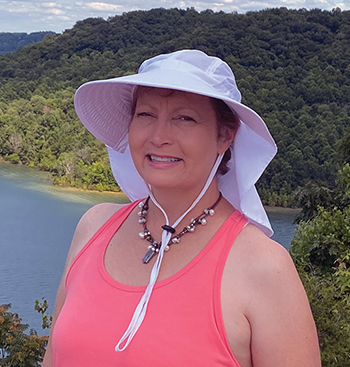Myelofibrosis Survivor
Research and Persistence have guided this survivor

Heidi Cascarano has faced three rare blood cancers — polycythemia vera (PV), myelofibrosis and myelodysplastic syndrome (MDS). The PV was kept at bay for nine years until it progressed to myelofibrosis. Drug therapy helped, but when new symptoms appeared, testing showed the condition had progressed to MDS with a chromosome mutation. After a successful stem cell transplant, Heidi is now cancer-free, riding horses again and living life to the fullest.
At my annual physical in 2008, my bloodwork showed abnormal numbers, and I was referred to a hematologist. He ran more tests and found the JAK2 mutation was present in my blood. I was diagnosed with polycythemia vera (PV).
The diagnosis was shocking. I was scared and feeling alone living in Chicago and missing my family in Tennessee. Then I lost my job and my health insurance ran out, so I paid for my treatments with cash. I was originally pre-med and had some medical knowledge, but I didn’t know anything about PV. So, I turned to the internet, but statistics online were scary. Life expectancy was not good, and there was an increased risk the PV could progress to myelofibrosis.
The hematologist recommended I start oral chemotherapy, but he admitted it would not reverse the disease and it would come with a lot of side effects. I only took one pill before deciding I wanted a second opinion.
The next doctor I met with recommended a treatment plan consisting of watching and waiting for symptoms while taking phlebotomies to reduce my red blood cell count and baby aspirin to prevent blood clots. PV can cause the blood to thicken and clot easily, so phlebotomies are used to reduce the number of red blood cells.
I followed that plan and, while I adjusted to living life with PV, I found several online support groups. The MPN Research Foundation and other sources offered great information. I also became more involved with my church and developed a stronger relationship with God.
In one of my groups, others were discussing a type of immunotherapy that could reverse fibrosis in bone marrow. My goal became to reduce or eliminate as much of the fibrosis as possible to prevent progression to myelofibrosis. I asked about trying immunotherapy, but the doctor felt the side effects would be worse than the disease. I trusted his decision and went on with my life.
Then over time, I started feeling more fatigued than I should and developed mild bone pain, itching and night sweats. I suspected something was wrong, so I asked for a bone marrow biopsy to confirm, but he didn’t think I needed one. I realized I needed a specialist who had experience with treating MPNs.
The specialist I found was wonderful. He ordered a bone marrow biopsy that revealed the PV had progressed to myelofibrosis. We decided to try immunotherapy, but it didn’t control it completely. We eventually switched to a targeted therapy. I felt much better on it, but it didn’t improve my white blood cell count, which remained low.
Looking for more options, I read that some doctors were combining immunotherapy with targeted therapy. I asked the doctor if I could take both. He feared the two would cancel each other out because one is an immune stimulant and the other is an immune suppressant. I was persistent, and he eventually agreed. It was successful, and I showed a great response.
About four years later, I started getting constant mouth sores. My gut told me something was wrong. Another bone marrow biopsy revealed I had a chromosome 7 deletion. I now had myelodysplastic syndrome (MDS) with a prognosis of only 18 months. That’s when my doctor and I discussed a stem cell transplant to try to save my life.
Six of my siblings were tested. None of them were a complete match, but my brother Carl was a 7/10 match, so we went with him. I am so grateful Carl made this sacrifice for me. Having the stem cell transplant brought us closer than we had ever been.
After the procedure, I spent a month in the hospital. The transplant reached 100 percent engraftment in three weeks, which was fantastic news. However, I developed ocular Graft-vs-Host Disease. My doctor sent me to the best GvHD specialists, and they treated it aggressively with steroid eye drops and autologous serum tears. I still take maintenance medications but am being weaned off them.
The last JAK2 test revealed I had no detectable mutations, and I’m considered cancer-free. I moved back to Tennessee and bought a horse. I had ridden when I was younger, but started up again with riding lessons to get comfortable. A year later, I was back to jumping.
HEIDI'S ADVICE...
Listen to your gut. You know your body best. Educate yourself about the disease so you know what questions to ask.
Accept what has happened so you can make a plan to move forward. Sticking your head in the sand will not make the cancer go away.
Be proactive. Find the best doctors who have experience treating your type of cancer. An MPN specialist is incredibly valuable.
Speak up for yourself, especially if you want to try something different.
Find support, whether that’s through friends or online groups. Talking with others going through a similar experience is helpful and educational.


